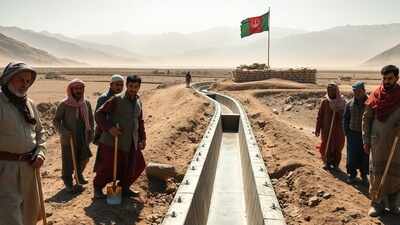After decades of war, Afghanistan is trying to assert sovereignty over its water resources. This is a shift testing vulnerable relationships with neighbouring countries. Since taking power in 2021, the Taliban has launched large-scale infrastructure projects, including dams and canals, taking advantage of the river flows that run out of Iran, Pakistan and Central Asia. However, according to the press agency AFP, these efforts have encouraged conflict, with climate change exacerbating water shortages across the region.
Central Asia Exploring Qosh Tepa Canal
The most controversial initiative is Qosh Tepa Canal, a megaproject designed to irrigate 560,000 hectares of farmland in northern Afghanistan. Experts say it could divert up to 21% of Amdarya’s flow. Uzbekistan and Turkmenistan, supported by Kazakhstan, issued warnings that the project could further reduce the Aral Sea and destabilize the placement of water sharing in areas dating back to the Soviet era.
Opinion survey
Do you think control over Afghanistan’s water resources will lead to more local conflicts?
Water governance specialist Mohd Faizee warned, saying from AFP “No matter how friendly the tone is now, at some point it will affect Uzbekistan and Turkmenistan when the canal starts to work.”However, Taliban officials argue that the canal does not cause any major harm. Project Manager Sayed Zabihullah Miri was quoted from AFP who said AMU Darya “has abundant water, especially when it is flooded or melted glacial water.” They argue that the project is important to boost food security in a country where climate-driven crop breakdowns and humanitarian crises are widespread.
Iran revives the Helmand conflict
Iran, a western neighbor of Afghanistan, is the only country with a formal water level treaty signed through the Helmand River in 1973. However, consent has never been fully respected. Tehran frequently denounces Kabul for limiting flow through upstream dams, especially during droughts. The Taliban argues that water shortages, exacerbated by climate change, cannot release more.A report by the Afghan network of analysts said Afghan authorities also believe that they have long been denied a significant share of Helmand’s waters due to poor management and political negligence. Meanwhile, the conflict boils through the Khalild basin that flows to Iran and Turkmenistan, where Afghanistan recently launched the Pashdandam. Analysts say that the war can reduce security risks after accelerating such projects and restructuring the local water dynamics.
Pakistan is looking closely at the Kabul Basin
To the east, Afghanistan shares the Kabul River basin with Pakistan, eventually feeding Indus. Unlike Iran, there is no treaty between two neighbors. Water conflicts do not control their rocky bilateral relations, but attempts to revive Kabul’s old river projects and build new projects can cause friction.However, Afghanistan’s financial struggle and lack of technical expertise means that most large projects will take years to complete. The delay could alleviate immediate diplomatic concerns, but waits could deepen the suffering for Afghans who are tackling severe water shortages in the capital and beyond.
Climate crisis promotes displacement
Afghanistan’s water conflict cannot be separated from climate emergency. Approximately 400,000 people were displaced in early 2025 due to floods, droughts and other climate shocks, according to the United Nations International Organization for Migration (IOM). “Crop breakdowns, dry pastures and lost water sources are pushing rural communities towards the edge,” the UN Food and Agriculture Organization warned in July.Northern villagers were quoted by AFP as saying that they are pinning hopes on the Qosh Tepa canal to revive agriculture, but it is still more than a year away. In contrast, the West Herat community watches the river Khalirud run as it dries, forcing families deported from Iran to return to barren land on their almost farms.Meanwhile, extreme rainfall added another layer of crisis. Warm temperatures mean that heavy rains will increase, and often lead to catastrophic flash floods. At Maidan Waldak, a community leader said, “I’m about 54 years old and have never experienced any of these issues.”Taliban officials acknowledge that their efforts are inadequate. Energy and Water Minister Abdul Latif Mansour recently admitted that while a canal and dam project is ongoing, “the measures we have taken so far are not sufficient.” Limited funding, international isolation and restrictive governance have made Afghanistan struggle to deal with the climate shock, even in the face of one of the world’s worst humanitarian crises.For millions of Afghans, the Taliban push to control the river becomes a critical issue for the country and its neighbors, so everything falls into the water in times of droughts.



